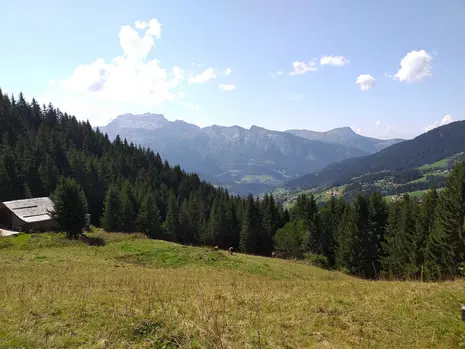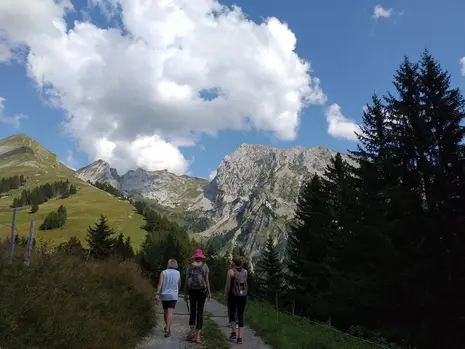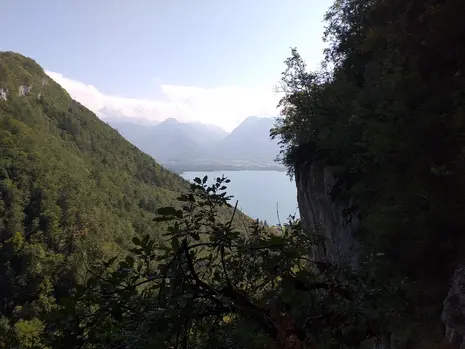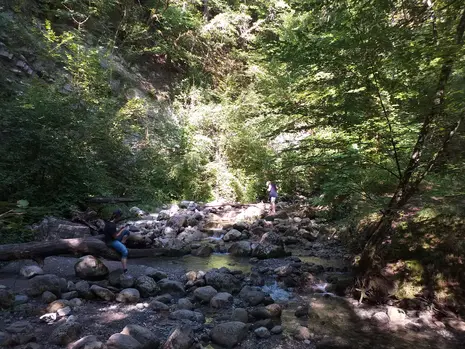“Sweet Mountains—Ye tell Me no lie” – Exploring the American Wilderness in Manigod, 2019
From August 25 to September 1, 2019, a group of graduate and postgraduate students from the fields of History and American Studies embarked on an excursion led by Profs. Christine Gerhardt (American Studies) and Sabine Freitag (Modern and Contemporary History) that perfectly combined a geographical journey to Manigod in the French Alps with an academic exploration of the American “wilderness.” This connection was so well-taken because in the American 19th century, (white, middle-class) wilderness discourses were strongly inspired by ideas about, and experiences in, the European Alps.
Setting off to scrutinize “Nature and Environment in Nineteenth-Century American History, Literature, and Culture,” or else “Die Entdeckung der Wildnis: Natur und Kultur im Amerika des 19. Jahrhunderts,” we approached the topic from various historical, literary, and cultural studies perspectives. Thus, our readings included excerpts from S. Alice Callahan’s seminal Native American novel Wynema: A Child of the Forest (1891) about the Massacre at Wounded Knee, and from Mexican-American author María Ruiz de Burton’s novel The Squatter and the Don (1885), as well as textual examples from one of the most quintessential American genres, the slave narrative. Our analyses of these texts, among others, demonstrated the importance of diverse and multicultural perspectives on the alleged dualism of “nature” and “culture.” In fact, a historiographical approach to this topic revealed just how formative German-American writers were for American debates about nature and culture, as illustrated by our readings of influential German-American newspaper articles of the time. The texts highlighted the productivity of frequently sidelined voices for a reconsideration of said nature-culture binary, and the and relevance of nature imagery as a carrier of manifold cultural meanings during a period of profound socio-cultural conflict and transition in the US-American context.
Since this seminar focused specifically on the literary periods of Romanticism and Transcendentalism, discussing Henry David Thoreau, Herman Melville, Walt Whitman, and Emily Dickinson provided intriguing insights into examples of American nature writing and early preservationist efforts. Hence, in “Walking” (1863), Thoreau idealizes American “wildness” and human-nature relationships as essential for developing a (hu)man’s full potential, and for constituting the American nation’s Manifest Destiny, while Melville’s descriptions of “The Whiteness of the Whale” in Moby-Dick (1851) impressively expose hubristic human opposition to nature’s forces as futile. Likewise, Whitman’s views of the natural environment in Leaves of Grass (1892) oscillate between images of a powerful nature with whom the speaker seeks interconnection (“This Compost”), and images of an untamed wilderness whose terrors are not overcome by mere interaction and must, instead, be domesticated (“O Magnet South”). In poems like these, Whitman is responding to conflicting discourses of conservationism and expansionism, prevalent in nineteenth-century American society. Further, reading Emily Dickinson’s seemingly light-hearted and private poems about her observations of the natural environment (“A Bird came down the Walk – ” ) or about a brisk walk during the time of the American Civil War (1861-65) (“The name - of it - is ‘Autumn’”) instead revealed that the poet linked her yearning for a unique form of poetic self-expression to an equally intense concern with public socio-political issues of the time.
Lastly, we traced the history of American conservationism from the historical development of national parks to its literary representations in Sarah Orne Jewett’s short story “A White Heron” (1886) and John Muir’s essay “A Wind Storm in the Forest” (1894). Both texts express ideas about a deep connection to the natural environment as a source of energy, and ideals about the natural world as a place of repose. Throughout the seminar, our own surroundings in the enchanting, imposing French Alps provided the perfect place to engage with these visions of nature’s inspiration and kinship, leaving us not only with a richer and more complex view of “Nature and Environment in Nineteenth-Century American History, Literature, and Culture”, but also with a more nuanced understanding of our own culture’s nature-related ideas, hopes, and fears – and, of course, with a bundle of lovely memories.




